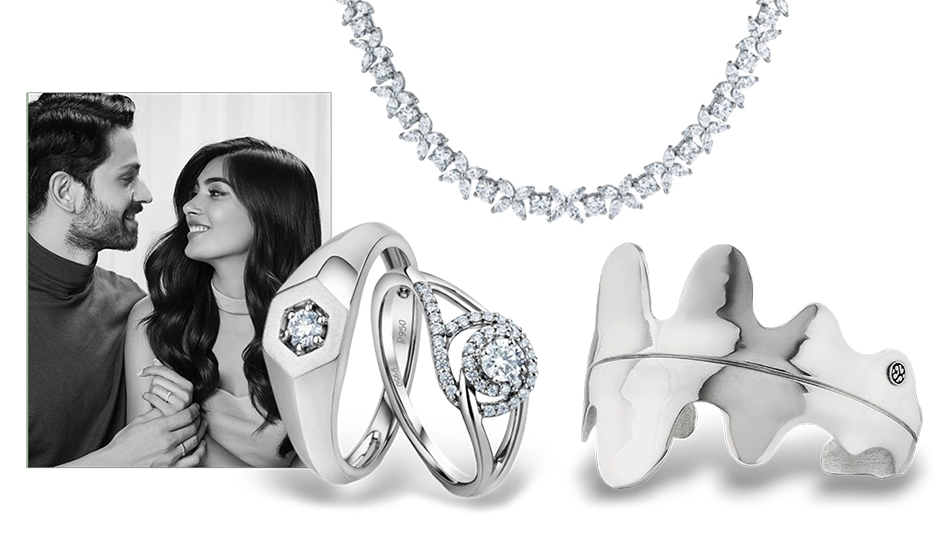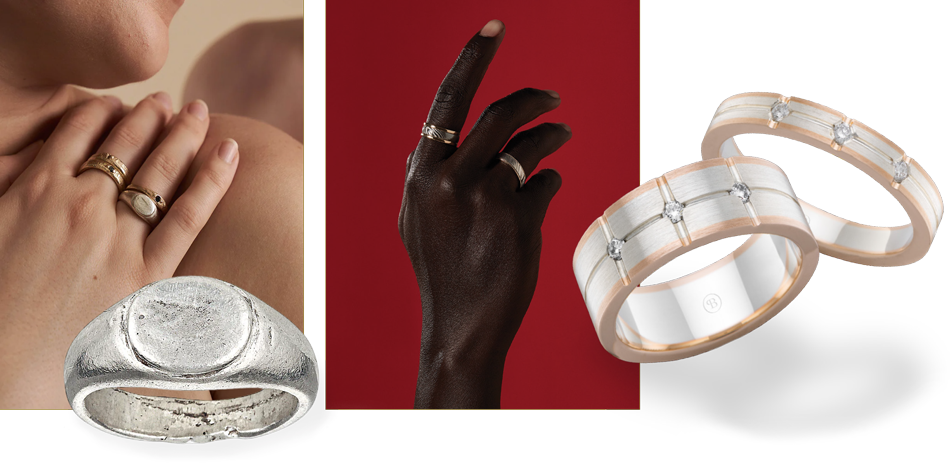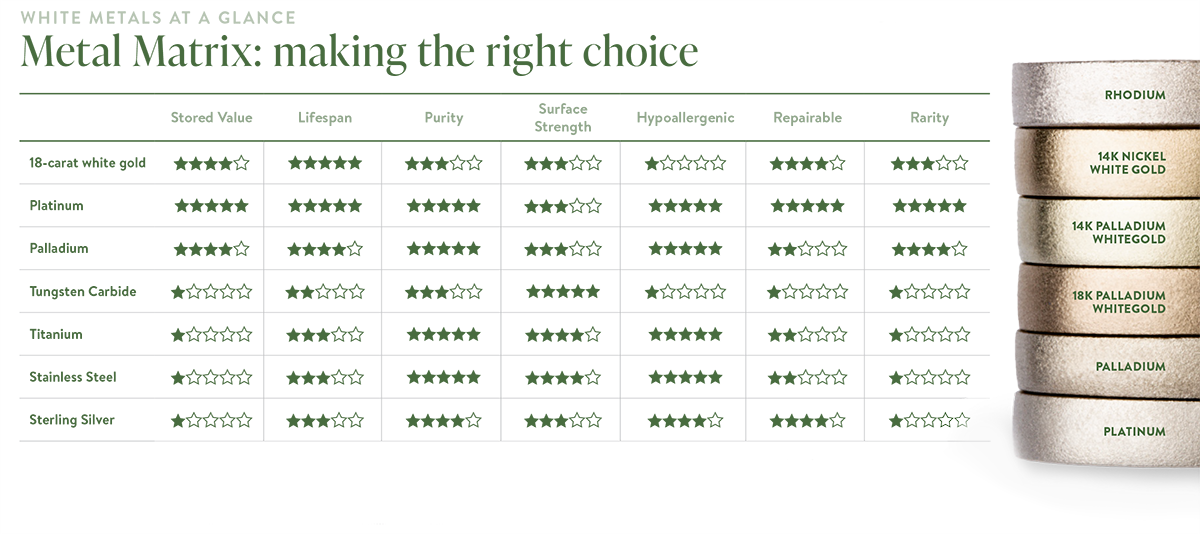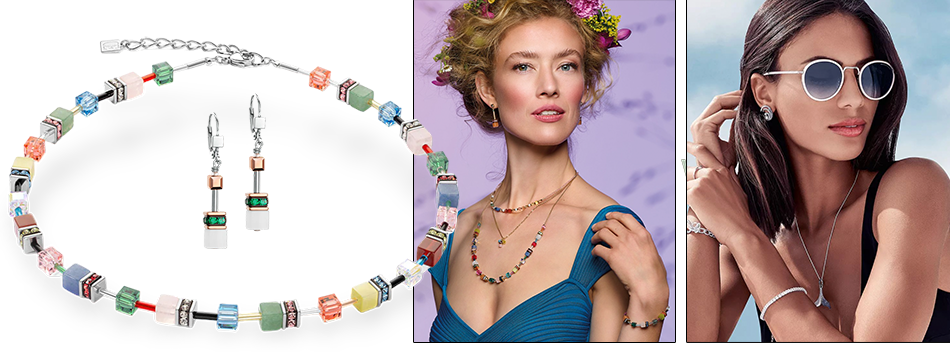When it comes to white metal jewellery, consumers are spoiled for choice. Whether it be platinum, palladium, white gold, silver, stainless steel, or titanium, there’s something for everyone – and each metal has its own unique strengths and weaknesses.
Platinum, palladium, and white gold are the more expensive choices; however while stainless steel, silver, and titanium are easier on the hip pocket that doesn’t mean they’re incongruous with meaningful adornments.
From engagement and bridal jewellery to pieces intended to be worn each day, white metals can meet both budget constraints and design desires.
With that said, this leaves retailers facing a significant conundrum: how do you know which white metal jewellery to offer?
While it’s undoubtedly a positive that consumers have more choices now than ever before when it comes to metals and alloys, this leaves retailers with an expanding pool to choose from when it comes to selecting stock.
After all, a jeweller can’t afford to offer every option under the sun!
So, how does a retailer make this decision? Listening to feedback from customers is one thing; however, hearing the insight from jewellers facing the same conundrum is even better.
|
 |
| L to R: Platinum Guild International, Tiffany & Co., Sophie Simone Designs |
|
Perfect platinum
Platinum is one of the rarest elements in the Earth’s crust, with only a few hundred tonnes produced each year. Approximately 80 per cent of platinum is sourced from South Africa.
Platinum is one of the least reactive metals, and has an excellent resistance to corrosion even at high temperatures – earning it the title of a ‘noble metal'.
Based in Bondi Beach, Sian Jones is the owner of Bert Jewellery. Jones says that when customers enter her store looking for white metal jewellery, she’s always quick to recommend platinum.
“Platinum is definitely the way to go. I personally don’t work with palladium, silver, stainless steel or titanium, but I certainly work with white gold and platinum,” she tells Jeweller.
“I always recommend platinum over white gold to my female customers simply because it doesn't need to be rhodium plated and the brightness of it looks fantastic next to diamonds.
“Personally, I dislike the look of white gold set with diamonds once rhodium plating wears off, whereas longevity-wise, platinum always looks good and retains that lovely colour.”
Jones has a different perspective when it comes to men’s wedding rings; however, especially those that don't feature diamonds.
She recommends unplated white gold for men because the ‘understated’ aesthetic is often ideal.
Jones is far from the only jeweller to recommend that retailers pursue platinum products.
A short drive from Bondi Beach, Stuart Alexander Goldsmith Jeweller is owned by a craftsman with four decades worth of hands-on experience.
Alexander says that after entering the industry in the 1980s, he quickly developed an appreciation for platinum.
“I would say that 90 per cent of the work I do is in platinum, it’s a truly glorious metal to work with,” he explains.
“Platinum needs hardly any maintenance other than a quick buff now and then. There’s no rhodium plating involved and comparable prices to 18-carat gold means it is always preferred.”
Jones agreed with Alexander that rhodium plating is an important factor to consider.
“The biggest appeal, in my opinion, with platinum is its beautiful everlasting colour and the fact it doesn't have to be ‘rhodiumed’,” she says.
“However, the fact that platinum is so strong is fantastic too in terms of main prongs on engagement rings.”
She continues: “Another benefit of platinum is that it is hypoallergenic, so I recommend it, especially for customers who may have had a reaction to certain jewellery or alloys in the past or those who have sensitive skin.”
Rhodium plating is also an important consideration for Kate Higgins, the owner of Eli Speak Jewellery in Melbourne, which specialises in handcrafted wedding and engagement rings.
“For my customers, it's a fairly even split between 18-carat white gold and platinum. My designs usually work well in Platinum, and the current pricing of these two metals works out fairly similar,” she explains.
“The selling point of beautiful bright-toned platinum with no rhodium plating maintenance often helps too.”
|
 |
| L to R: Zoe Alexandria, BECKS Group |
|
Shiny silver
While platinum has many valuable qualities, it’s far from a ‘perfect’ metal for jewellery. Working with platinum can be complicated, particularly due to its high melting point.
Overall, it’s been said that working with platinum requires a significant deal more skill and artistry than with gold.
Jones noted that she doesn’t work with silver, while Alexander suggested that he only offers silver jewellery by special request.
These responses may come as a surprise to those not overly familiar with the minutia of jewellery manufacturing.
Silver has been valued as a precious metal for thousands of years - soft, white, and lustrous it exhibits the highest reflectivity of any metal.
Working out of her studio in Sydney, Zoe Richardson is the owner of Zoe Alexandria – a brand that she says prides itself on the ‘slow jewellery’ approach. By ‘slow’,
Richardson explains that an emphasis is placed on sustainable practices.
Richardson takes pride in resurrecting older, overlooked jewellery into timeless pieces with emotional value and says that silver is often an important part of that process.
“Silver is the most popular white metal with my customers, followed by white gold,” she tells Jeweller.
“I think it’s mostly popular due to its affordable price point and the fact that most people recognise silver as a metal but a lot of them don’t really know much about white gold.”
Indeed, while the top end of the white metals category is often sensitive to macroeconomic fluctuations, silver and stainless steel traditionally experience stable prices and steady demand.
This stability makes these metals popular with jewellery retailers and consumers. Established in Melbourne in 2013, Scarlett Jewellery Label aims to create handcrafted fine jewellery suitable for effortless everyday wear.
Owner Rebecca Shearer says that when it comes to selecting white metal jewellery offerings, retailers need to be sensitive to consumer budgets.
“Silver presents an opportunity for lower-priced, more affordable pieces, which can be worn more casually,” she tells Jeweller.
Shearer focuses her efforts on signet rings, engagement rings, wedding bands, and personalised gifts and says that in recent years, it’s difficult to look past the popularity of platinum.
“People are quite open to either white gold or platinum, but now that a platinum engagement ring is comparable in pricing to a white gold ring,” she says.
“Customers appreciate the durability and strength of platinum, as well as the fact that they won’t need to rhodium plate their ring.”
She adds: “People like the weight of platinum, the heaviness feels precious and valuable.”
|
 |
| Choosing the correct metals for a jewellery piece is an important decision – the more you know about how each metal performs and looks, the better your choice will be. |
|
Wonderful white gold
Arda Kara is the owner of Melbourne-based Fidda & Katina, a business that began with sterling silver pieces and evolved its offerings to include engagement rings and wedding bands.
Kara says that since entering the bridal jewellery market, he’s noticed one particular white metal is always in high demand.
“Ever since we began offering custom-made engagement and wedding rings, we've found that 18-carat white gold is by far the most frequently chosen metal by our clients,” he tells Jeweller.
“The biggest appeal of white gold lies in its elegant and timeless appearance. Its lustrous and bright finish complements a wide range of diamonds and precious stones, making it a versatile option for various jewellery designs, from engagement rings to necklaces and bracelets.
He added: “It is perfect for both casual and formal occasions and adds a classic charm to any outfit.”
White gold is an alloy of gold and at least one white metal (usually nickel, silver, or palladium) and the properties of the alloy vary depending on the metals used and their proportions.
White gold is traditionally popular with high-end jewellers, where the price is less of a question for customers. Kara says that jewellery featuring white gold exudes elegance.
“The most common feedback we receive from our customers is that they love the brilliant shine, particularly when paired with diamonds. We find that our customers love the sophisticated and timeless appearance that white gold offers,” he reveals.
Misconceptions and misunderstandings
It should come as no surprise that as the range of white metal jewellery on offer expands, misconceptions impacting consumer decision-making continue to increase.
“Consumers don’t often realise that white gold is more of a grey colour and that the majority of the time it’s rhodium plated,” Richardson explains.
“Another thing I’ve noticed is that many customers will refer to white gold as ’silver’ because they don’t understand the difference. When we talk about gold, most people assume we’re talking about yellow.”
Interestingly, Jones noted a similar phenomenon when dealing with her customers and says that offering education and insight wherever possible is an excellent way to build rapport.
“Surprisingly, most of my customers that want a white metal engagement ring or wedding ring ask for a ‘silver’ ring,” she reveals.
“I always correct them and explain the qualities of white gold and platinum and let them decide which they'd prefer. Consumers still aren't aware of the differences between white gold and platinum.”
Higgins says that the most common feedback she hears from customers is that they need their jewellery to be resilient to the incidental knocks, bumps and scratches of everyday life.
She takes this into consideration during the design process.
“Customers find white metals hard-wearing, which is important in today's busy lifestyle. I handmake all my pieces, so the white metals are as hardwearing as they could be,” she says.
“White metals like platinum have a certain innate opulence, which is appealing. It has an association with Art Deco jewellery too, which many of my designs are influenced by and my customers like that.“
|
 |
| L to R: Coeur de Lion, Thomas Sabo |
|
Can I help you with anything else?
Whether a retailer decides to pursue the upper echelon of the market with platinum and white gold jewellery or focuses on providing more affordable alternatives via silver and stainless steel, one thing remains clear – the importance of education.
“I think it’s really important to educate consumers about the different types of metals available to them and what is most appropriate for the job at hand,” Richardson advises.
“As an example, we offer our white gold pieces raw – without rhodium plating - and I always let customers know that rhodium is a surface finish and requires maintenance which is something to consider when choosing their piece.”
Jones says that she takes a similar approach. “Interestingly, many customers are surprised when I explain that most white gold is rhodium plated,” she says.
“I think it's important to be transparent with customers about the fact that their white gold rings that have been rhodium plated won't look that way forever with everyday wear.”
Indeed, with an ever-expanding range of white metal jewellery available for retailers to showcase to customers, so comes an ever-increasing responsibility for jewellers to educate these consumers on their unique strengths and weaknesses.
While this may initially seem like a time-intensive burden for already busy jewellers, the good news is that educating consumers is an avenue for increasing rapport and improves the chances of repeat business.
Loyal customers and repeat business are, after all, the lifeblood of all retail operations. What better way to cement this relationship than by guiding a confused or misinformed consumer through the complex world of white metal jewellery?
Research suggests that consumers are more likely to purchase from a business or brand if they engage with ‘early-stage’ educational content.
This is a compelling insight and suggests that in order to win customers and keep their loyalty, you must exceed their expectations in solving their problems.
Customers want quality and convenience, and to be able to understand the product they are buying. Customer education is ideal for meeting these expectations.
It’s about giving customers a unique experience by informing them about the value, functionality, and characteristics of your jewellery. You might know everything there is to know about white metal jewellery; however, chances are your customers doesn’t!
With the right information, customers will be satisfied with the knowledge that they are making an informed purchase.
More importantly, they’ll head home knowing that your business is responsible for that satisfaction.
Read eMag